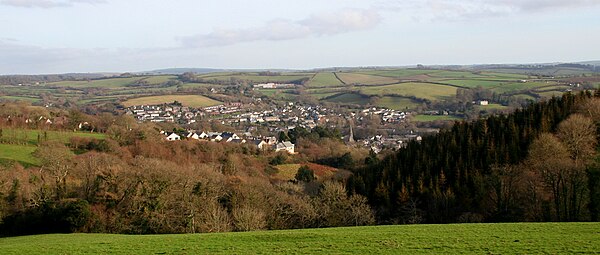Lostwithiel
| Lostwithiel Cornish: Lostwydhyel | |
| Cornwall | |
|---|---|
 Lostwithiel | |
| Location | |
| Grid reference: | SX104598 |
| Location: | 50°24’27"N, 4°40’11"W |
| Data | |
| Population: | 2,739 (2001) |
| Post town: | Lostwithiel |
| Postcode: | PL22 |
| Dialling code: | 01208 |
| Local Government | |
| Council: | Cornwall |
| Parliamentary constituency: |
South East Cornwall |
Lostwithiel is a small town in Cornwall at the head of the estuary of the River Fowey. The Fowey river valley rises each side of the town, and through the town runs the A390 road from Tavistock to Truro.
The town has a fine mediæval bridge over the Fowey.
Lostwithiel station is on the Cornish Main Line from Plymouth to Penzance. The line was originally built for the Cornwall Railway which built its main workshops here, but the surviving workshop buildings were transformed into apartments in 2004. A branch line takes china clay trains to Fowey.
The town contains the suburbs of Bridgend to the east and Rosehill and Victoria to the west of the River Fowey.
According to the 2001 census it had a population of 2,739.
Name
The whistful name "Lostwithiel" is of an origin much debated. The main theory is that it comes from the Cornish language, in which "lostwydhyel" (or Lost Gwydhyel) means "tail of a wooded area".[1][2] The view from Restormel Castle looking towards the town shows how this may have come to be.
In the 16th century it was thought that the name came from the Roman name Uzella, translated as Les Uchel in Cornish. In the 17th century popular opinion was that the name came from a translation of Lost (a tail) and Withiel (a lion), the lion in question being the lord who lived in the castle.
History
Lostwithiel is a historic borough. The Borough of Lostwithiel was one of many tiny boroughs in Cornwall whose status permitted them to elect two members to the House of Commons, but the borough was disenfranchised by the Reform Act 1832. It remained a municipal borough until the 1960s.
The seal of the borough of Lostwithiel was a shield charged with a castle rising from water between two thistles, in the water two fish, with the legend "Sigillum burgi de Lostwithyel et Penknight in Cornubia".[3] Its mayoral regalia includes a silver oar, signifying its former jurisdiction over the River Fowey.

Buildings
Lostwithiel's most notable buildings are St Bartholomew's Church and Restormel Castle. There is a small museum devoted to the history of the town. Once a stannary town, and for a period the most important in Cornwall, it is now much reduced in importance. There is a fine early fourteenth century bridge with five pointed arches, and nearby the remains of the Stannary Court, with its Coinage Hall - this was the centre of royal authority over tin-mining, and 'coinage' meant the knocking off of the corner of each block of tin for the benefit of the Duchy of Cornwall. The small Guildhall has an arcaded ground floor. The old Grammar School has been converted into dwellings.
-
The old Duchy Palace
-
The old Fire Station
-
The Methodist Church in Queen Street
Culture
The town has a playing field known as King George V Playing Field. Lostwithiel has several large parks including Coulson Park which was named after Nathaniel Coulson (the San Francisco property magnate) who was raised in Lostwithiel after being abandoned by his father.
The town boasts a number of annual cultural activities including an arts and crafts festival, a beer festival, a week long carnival in the summer, food and cider festivals in the October, and a Dickensian evening in December.[4]


Outside links
| ("Wikimedia Commons" has material about Lostwithiel) |
- Lostwithiel Town Council
- Lostwithiel.org.uk run by Lostwithiel Business Group
- GENUKI page
- Lostwithiel Bridge and its Memories - The Reverend Canon E Boger, 1887
- Lostwithiel OCS
- Cornwall Record Office Online Catalogue for Lostwithiel
References
- ↑ Weatherhill, Craig (2009) A Concise Dictionary of Cornish Place-Names. Westport, Mayo: Evertype
- ↑ Mills, A. D. (1996). The Popular Dictionary of English Place-Names. Parragon Book Service Ltd and Magpie Books. ISBN 0-7525-1851-8.
- ↑ Pascoe, W. H. (1979). A Cornish Armory. Padstow, Cornwall: Lodenek Press. p. 133. ISBN 0-902899-76-7.
- ↑ "Annual Events". Welcome to Lostwithiel. Lostwithiel Business Group. http://www.lostwithiel.org.uk/whats-on/annual-events/. Retrieved 2011-02-22.


